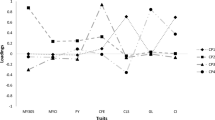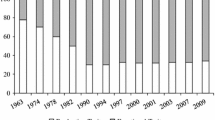Summary
A matrix program to predict short term genetic gain from single trait selection for milk yield was developed. Rate of genetic gain was calculated as the annual change in the mean breeding value of all producing females. Several parameters sets representing various selection policies were used to examine situations pertinent to dairy populations of the United States. Approach to the asymptotic rates of genetic gain within the model varied with the choice of parameters, but even with consistent selection policies, predicted total genetic gain in the first 10 years was only half of the expected from classical theory. Considerable year to year variation in the rate of gain occurred. Early gains were more dependent on female selection decisions than gains during the steady state. In a two-phase model, the approach to the linear rate of gain in the second phase was accelerated by starting with an ongoing improvement program, but considerable delays still existed. Selection for sex- limited traits such as milk yield, which require pedigree selection and a waiting time for progeny test results reached asymptotic rates more slowly than previously assumed.
Similar content being viewed by others
References
Becker WA (1975) Manual of quantitative genetics, 3rd edn. Academic Enterprises Pullman, p 147
Bichard M (1971) Dissemination of genetic improvement through a livestock industry. Anim Prod 13:401–411
Bichard M, Pease AHR, Swales PH, Ozkutuk K (1973) Selection in a population with overlapping generations. Anim Prod 17:215–227
Brascamp EW (1975) Model calculations concerning economic optimalization of AI-breeding with cattle. Centre for Agricultural Publishing and Documentation, Wageningen Ag Res Rep 846
Brascamp EW (1978) Methods of economic optimization of animal breeding plans. Research Institue for Animal Husbandry, Zeist Rapp B-134
Burnside EB, Legates JE (1967) Estimation of genetic trends in dairy cattle populations. J Dairy Sci 50:1448–1457
Dentine MR (1985) Modeling of rates of genetic progress and investigation of traits associated with longevity in dairy cattle. PhD Dissertation, North Carolina State University, Raleigh NC
Dickerson GE, Hazel LN (1944) Effectiveness of selection on progeny performance as a supplement to earlier culling in livestock. J Agric Res 69:459–476
Guy DR, Smith C (1981) Derivation of improvement lags in a livestock industry. Anim Prod 32:333–336
Harville DA, Henderson CR (1967) Environmental and genetic trends in production and their effects on sire evaluation. J Dairy Sci 50:870–875
Hill WG (1971) Investment appraisal for national breeding programmes. Anim Prod 13:37–50
Hill WG (1972) Effective size of populations with overlapping generations. Theor Popul Biol 3:278–289
Hill WG (1974) Prediction and evaluation of response to selection with overlapping generations. Anim Prod 18:117–139
Hill WG (1977) Selection with overlapping generations. Int Conf Quant Genet, Iowa State University Press, Ames, pp 367–378
Hinks CJM (1970a) The selection of dairy bulls for artificial insemination. Anim Prod 12:569–576
Hinks CJM (1970b) Performance test procedures for meat production amongst dairy bulls used in A I. Anim Prod 12:577–583
Hintz RL, Everett RW, Van Vleck LD (1978) Estimation of genetic trend from cow and sire evaluations. J Dairy Sci 61:607–613
James JW (1979) Selection theory with overlapping generations. Livest Prod Sci 6:215–222
Jansen J, Laarhoven A van, Brascamp EW (1984) Selection against undesirable recessive genesis in A. I. cattle populations with overlapping generations. Z Tierz Züchtungsbiol 101:220–228
Langholz VHJ (1973) Die Schätzung des genetischen Fortschrittes in KB-Zuchtprogramm beim Zweinutzungsrind. Z Tierz Züchtungsbiol 90:149–159
Lee KL, Phillipsson J, Freeman AE (1980) Trends in the selection practiced in Holsteins bred artificially in the United States. J Dairy Sci (Suppl) 63:127
Lee KL, Freeman AE, Berger PJ, Johnson LP (1983) Genetic change in the registered Holstein cattle population. 78th Annual Meeting of American Dairy Science Association, P-48
McClintock AE, Cunningham EP (1974) Selection in dual purpose dairy cattle populations: defining the breeding objective. Anim Prod 18:237–247
Ollivier L (1974) Optimum replacement rates in animal breeding. Anim Prod 19:257–271
Olson KE, Jensen EL (1976) Estimation of genetic trend in Wisconsin Holsteins. J Dairy Sci (Suppl) 59:74
Powell RL, Freeman AE (1974) Genetic trend estimators. J Dairy Sci 57:1067–1075
Rendel JM, Robertson A (1950) Estimation of genetic gain in milk yield by selection in a closed herd of dairy cattle. J Genet 50:1–8
Robertson A, Rendel JM (1950) The use of progeny testing with artificial insemination in dairy cattle. J Genet 50:21–31
Searle SR (1961) Estimating herd improvement from selection programs. J Dairy Sci 44:1103–1112
Smith C (1960) Efficiency of animal testing schemes. Biometrics 16:408–415
Smith C (1962) Estimation of genetic change in farm livestock using field records. Anim Prod 4:239–251
Smith C (1969) Optimum selection procedures in animal breeding. Anim Prod 11:433–442
Sorensen DA, Kennedy BW (1983) The use of the relationship matrix to account for genetic drift variance in the analysis of genetic experiments. Theor Appl Genet 66:217–220
Specht LW, McGuilliard LD (1960) Rates of improvement by progeny testing in dairy herds of various sizes. J Dairy Sci 43:63–75
Van Vleck LD (1964) Sampling the young sire in artificial insemination. J Dairy Sci 47:441–445
Van Vleck LD (1977) Theoretical and actual progress in dairy cattle. Int Conf Quant Genet, Iowa State University Press, Ames, pp 543–568
Van Vleck LD, Henderson CR (1961) Measurement of genetic trend. J Dairy Sci 44:1705–1710
Author information
Authors and Affiliations
Additional information
Communicated by E.J. Eisen
Rights and permissions
About this article
Cite this article
Dentine, M.R., McDaniel, B.T. Expected early genetic gain from selection for milk yield in dairy cattle. Theoret. Appl. Genetics 74, 753–757 (1987). https://doi.org/10.1007/BF00247553
Received:
Accepted:
Issue Date:
DOI: https://doi.org/10.1007/BF00247553




